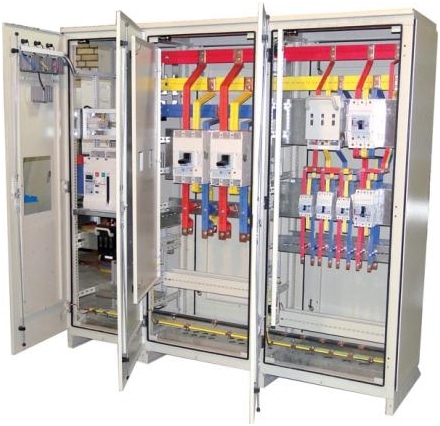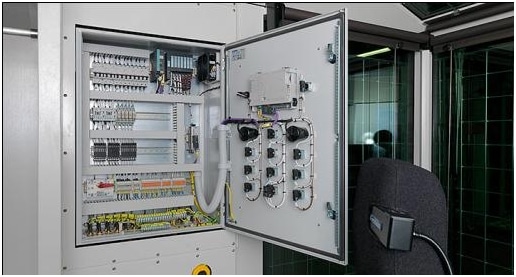
Enjoy!
Introduction
The switchboard and switchgear are two important systems that control how power is delivered to electrical circuits. The two terms are sometimes used interchangeably. However, it is important to note that they perform different functions and usually designed to work together in series so as to provide the maximum coordination and protection.
Since the two have different functions and capabilities, they are suited for different types of installations or at different stages of an electrical network. Whether to use switchgear, a switchboard, or both, depends largely on the design and requirements of the power system. To understand where each fits, we will have a look at their functions and differences.
The switchgear
The switchgear refers to the collection of the switching devices required for a low, medium or high voltage electrical circuit. It consists of switching and protection devices such as fuses, circuit breakers, isolators, disconnect switches, relays and other devices that control the flow of electricity.
These devices are used to switch the electric power on and off for transformers, motors, generators, transmission lines, and power networks in homes, commercial, industrial, transmission and distribution systems.
The switchgear consists of two main components:
-
- Power switching/conducting component such as a circuit breaker, fuse, or lightning arrester that can disconnect the flow of power when there is a fault.
- Power control components such as protective relays, control panels, current transformers and other devices to monitor, protect and control the power conduction components and the electrical equipment.
The switchgears are used at various points of an installation. In the industrial setup, the switchgear controls the power to the manufacturing processes while at the utilities, the switchgear is used to run the electric grid. In commercial buildings, it is used to supply and control power to the loads while providing protection to the loads and the installation.
The switchgear permits the switching on and off of the generators, electrical equipment, transmission, distributors and other circuits during the normal operating conditions. However, under fault conditions, the switchgear is designed to detect the faults and interrupt the flow of electricity to the affected section, thus disconnecting and isolating it from the healthy circuit.
For efficient operation, the switchgear should be quick in operation and have an option of manual control to be used when the automatic feature is not working.
The switchgears are required at all switching points of an electrical network. The ratings of the devices at each stage depend on the voltage levels at that point. Other than in distribution and transmission networks, the switchgears are used in residential, commercial, industrial circuits.
The switchgears are classified according to the voltage levels involved in the circuit of application. The three classes are:
-
- High voltage Switchgear
-
- Medium voltage Switchgear
- Low voltage Switchgear

Figure 1: Medium voltage switchgear | image: mttiran.com
Due to the dangerous voltages and currents that the switchgear elements carry, the access must be restricted in one form or another based on the type of the facility. The switchgears are either outdoor or indoor. A fence with warning signs are used to restrict access to outdoor substations, while metal enclosures and cabinets are used in commercial and industrial buildings to prevent the technical as well as public from coming into contact with the live elements and parts.
The electric switchboard
The switchboard refers to a large single panel, assembly of panels, a structural frame or assembly of structural frames, on which buses, switches, and protective and other control devices may be mounted. The mounting may be done on the face, the back side, or both.
The electrical distribution equipment is designed to redirect and control the flow of electricity from one or multiple sources, to several different sections or loads. A switchboard can therefore be used to distribute power to individual loads, control equipment, transformers, panel boards etc.
The main role of the switchboard is to allow the incoming electric power to be divided into smaller independent circuits according to their current requirements. The circuit breakers as well as over current protection devices for each of the sections are selected according to the load current.
Once the currents are divided, they are then distributed according to the load i.e. lighting loads, sockets etc. Some switchboards such as those used in residential apartments have an option of metering to see the amount of power used by individual circuits.

Figure 2: Distribution switchboard | image: scancab.com
Major components of a Switchboard
-
- Panels or frames: to hold devices such as switches, circuitry indicates and other devices that allow the delivery of power and controlling of the circuits.
-
- Controls and monitoring devices: To connect and control single or multiple power sources to and from the switchboard. These may include frequency gauges, synchroscopes and other instruments to measure the frequency and synchronization of the power generators.
- Busbars: To carry and distribute the incoming power from source to different sections of the installation through the switchboard and control devices.
Differences between switchgears and switchboards
The main difference is the voltage that they are designed to handle. The switchboards are generally for voltages less than 600 volts, while the switchgear systems are designed for higher voltages reaching up to 350 KV.
There are major differences in the hardware and design of the two systems. For example, due to the functions and high power handling capacity in switchgears, they use devices such as high power rated circuit breakers. Further, these circuit breakers as well as other devices can be replaced or withdrawn when the system is still operating.
The switchgear devices are mechanisms that enable the connection and disconnection of the electrical power to other circuits and loads. This comprises of devices such as fuses, the circuit breakers and relays.
The switchboard consists of mechanisms such as those in the switchgear system. However, the switchboard refers to a panel, structural frame or assembly of either, on which buses, instruments and mechanisms such as the protective devices and switches may be mounted.
The switchgears have robust constructions, are more flexible and reliable. However, they are more expensive than the switchboards.
Thanks for reading,
A.N
Looking forward to read all your comments and remarks in the comment section below!
In such a discussion, it could be useful to start from the official definition given by IEC:
Switchboard: part of a manual or manually supervised exchange at which the interconnection of circuits is manually controlled
Switchgear: a general term covering switching devices and their combination with associated control, measuring, protective and regulating equipment, also assemblies of such devices and equipment with associated interconnections, accessories, enclosures and supporting structures, intended in principle for use in connection with generation, transmission, distribution and conversion of electric energy
Then, of course, providing practical aspects, illustrations, examples, … can be very useful.
I agree with the comment given by Jacques Schonek. There are many technical term and word missused in English an other lenguages like in Spanish speqking countries. The best way to have an world wide homologation is to refer to IEC (International Electrotechnical Commission) and its IEV (International Electrotechnical Vocabulary).
Best Regards
My friend was telling me that there was a problem with his switchgear and I didn’t really understand what he was talking about. He described it as being a giant circuit breaker; it sounds like he’s about right based off what you said. Thanks for posting the article to help me learn and understand a little bit better.
The figure 1 can’t be a medium voltage switchgear.
I agrree with Jacques Schonek comment too.